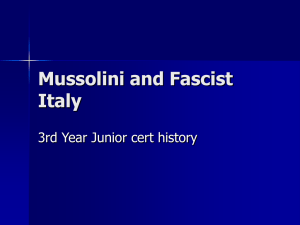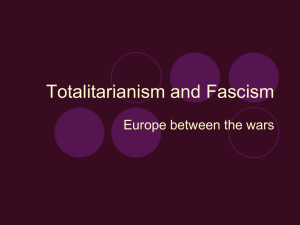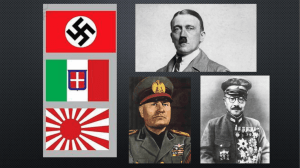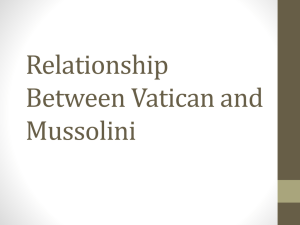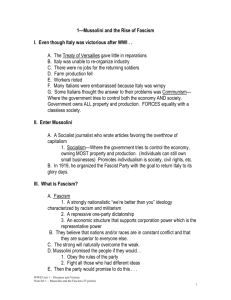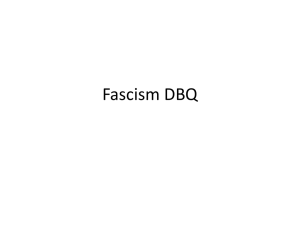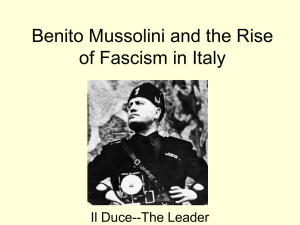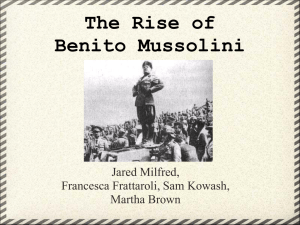webquest: benito mussolini - West Windsor
advertisement
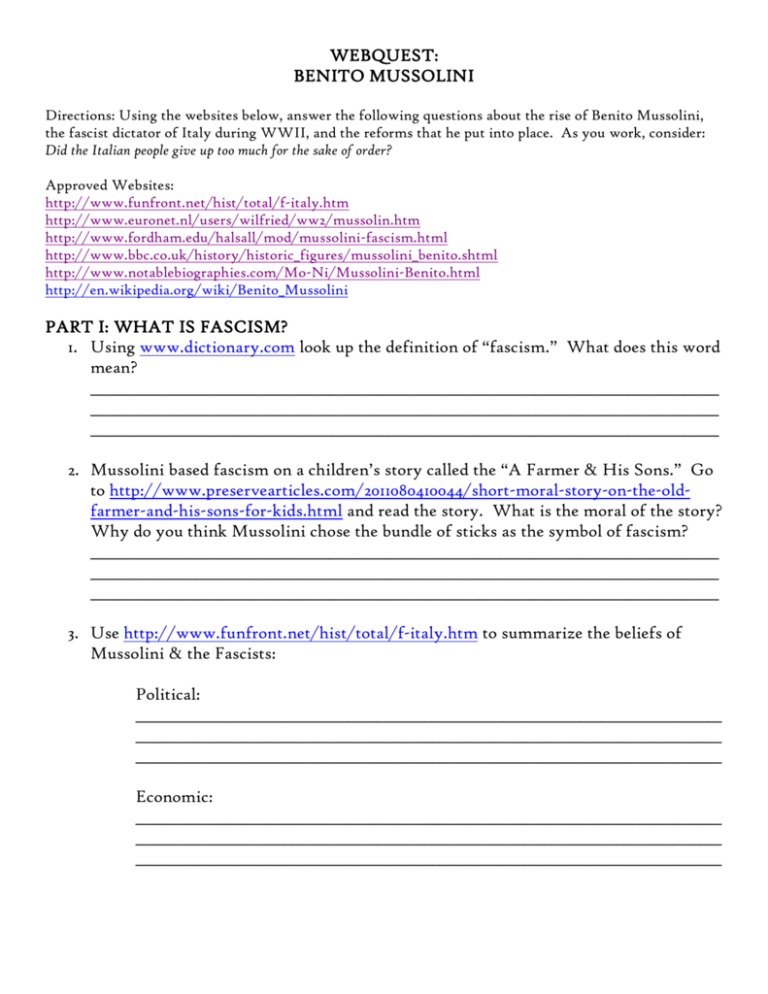
WEBQUEST: BENITO MUSSOLINI Directions: Using the websites below, answer the following questions about the rise of Benito Mussolini, the fascist dictator of Italy during WWII, and the reforms that he put into place. As you work, consider: Did the Italian people give up too much for the sake of order? Approved Websites: http://www.funfront.net/hist/total/f-italy.htm http://www.euronet.nl/users/wilfried/ww2/mussolin.htm http://www.fordham.edu/halsall/mod/mussolini-fascism.html http://www.bbc.co.uk/history/historic_figures/mussolini_benito.shtml http://www.notablebiographies.com/Mo-Ni/Mussolini-Benito.html http://en.wikipedia.org/wiki/Benito_Mussolini PART I: WHAT IS FASCISM? 1. Using www.dictionary.com look up the definition of “fascism.” What does this word mean? _________________________________________________________________________________________ _________________________________________________________________________________________ _________________________________________________________________________________________ 2. Mussolini based fascism on a children’s story called the “A Farmer & His Sons.” Go to http://www.preservearticles.com/2011080410044/short-moral-story-on-the-oldfarmer-and-his-sons-for-kids.html and read the story. What is the moral of the story? Why do you think Mussolini chose the bundle of sticks as the symbol of fascism? _________________________________________________________________________________________ _________________________________________________________________________________________ _________________________________________________________________________________________ 3. Use http://www.funfront.net/hist/total/f-italy.htm to summarize the beliefs of Mussolini & the Fascists: Political: ___________________________________________________________________________________ ___________________________________________________________________________________ ___________________________________________________________________________________ Economic: ___________________________________________________________________________________ ___________________________________________________________________________________ ___________________________________________________________________________________ Social: ___________________________________________________________________________________ ___________________________________________________________________________________ ___________________________________________________________________________________ Foreign Policy: ___________________________________________________________________________________ ___________________________________________________________________________________ ___________________________________________________________________________________ PART II: BACKGROUND ON BENITO MUSSOLINI 4. When was Mussolini born? _______________________________________________________ 5. Describe Mussolini’s family & childhood. _________________________________________________________________________________________ _________________________________________________________________________________________ _________________________________________________________________________________________ 6. During most of his life, Mussolini was a member of what political party? ____________________________________________________________ PART III: MUSSOLINI’S RISE TO POWER 7. What two problems were occurring in Italy after World War I? a. ____________________________________________________________________ b. ____________________________________________________________________ 8. What was the march on Rome? _________________________________________________________________________________________ _________________________________________________________________________________________ _________________________________________________________________________________________ 9. Who were the Black Shirts? _________________________________________________________________________________________ _________________________________________________________________________________________ _________________________________________________________________________________________ 10. What power was given to Mussolini after the Christmas Eve law of 1925? _________________________________________________________________________________________ _________________________________________________________________________________________ _________________________________________________________________________________________ 11. Using the website http://www.funfront.net/hist/total/f-italy.htm read through and find the 5 reasons why Mussolini & the Fascists were able to rise to power. What are they? a. b. c. d. e. _____________________________________________________________________ _____________________________________________________________________ _____________________________________________________________________ _____________________________________________________________________ _____________________________________________________________________ PART IV: MUSSOLINI’S POLICIES 12. Using http://www.funfront.net/hist/total/f-italy.htm what were the 5 reasons for Mussolini’s aggressive foreign policy? a. _____________________________________________________________________ b. _____________________________________________________________________ c. _____________________________________________________________________ d. _____________________________________________________________________ e. _____________________________________________________________________ Now, using the reading provided, find 5 examples that the Italian people gave up too much for the sake of order, and 5 examples that the Italian people did not give up too much when they took Mussolini as their leader. 1. Did the Italian people give up too much for the sake of order? YES NO 1. 2. 2. 3. 3. 4. 4. 5. 5. MUSSOLINI’S ITALY By 1925, Mussolini had assumed more power and took the title of “Il Duce” or “The Leader.” He suppressed rival parties, muzzled the press, rigged elections and replaced elected officials with Fascist supporters. In theory, Italy remained a parliamentary monarchy. In fact, it was a dictatorship upheld by terror. Critics were thrown into prison, forced into exile or murdered. Secret police and propaganda bolstered the regime. Economic Policy: To encourage economic growth and end conflicts between owners and workers, Mussolini brought the economy under state control. Unlike socialists, he preserved capitalism. Under Mussolini’s “corporate state” representatives of business, labor, government and the Fascist party controlled industry, agriculture and trade. Although production increased, this success came at the expense of the workers. They were forbidden to strike and their wages were low. Social Policies: To Fascists, the individual was unimportant except as a member of the state. Men, women and children were bombarded with slogans glorifying the state and Mussolini. “Believe! Obey! Fight!” loudspeakers blared and posters proclaimed. Men were urged to be ruthless, selfless warriors for the glory of Italy. Women were pushed out of paying jobs. Instead, Mussolini challenged women to “win the battle of motherhood.” Those who bore more than 14 children were given a medal by Il Duce himself. Shaping the young was a major Fascist goal. Fascist youth groups toughened children and taught them to obey string military discipline. Boys and girls learned about the glory of ancient Rome. Young Fascists marched in torchlight parades, singing patriotic hymns and chanting, “Mussolini is always right.” By the 1930’s, a generation of young soldiers stood ready to back Il Duce’s drive to expand Italian power. The Impact of Mussolini’s Rule: Mussolini built the first totalitarian state, which became the model for all others. Fascist rule, while not as absolute as Stalin’s rule of Russia or Hitler’s rule of Germany, shared several features with other absolute governments of the time period: 1) a single party dictatorship, 2) state control of the economy, 3) use of police spies and terror to enforce the will of the state, 4) strict censorship and government monopoly of the media, 5) use of schools and the media to indoctrinate people, and 6) unquestioning obedience for a single leader. Given it’s restrictions of individual freedom, why did fascism appeal to many Italians? First, it promised a strong, stable government and an end to the political feuding that had paralyzed democracy. Mussolini’s intense nationalism also struck a chord among most ordinary Italians. He revived national pride, pledging to make the Mediterranean Sea a “Roman lake” once more. Finally, Mussolini projected a sense of power and confidence in a time of disorder and despair. At first, Il Duce received good press outside Italy, too. Newspapers in Britain, France and North America applauded the discipline and order of his government. “He got the trains running on time,” admirers said. Only later, when Mussolini embarked on a course of foreign conquest did western democracies protest his actions. EXIT PASS: MUSSOLINI’S ITALY Directions: You have read and analyzed various sources about Mussolini and how his fascist government ruled Italy before World War II. Now, using your research, answer the question below. To receive full credit you must: 1) Choose a side; 2) Support your viewpoint with three pieces of historical evidence from your studies; and 3) sum up your viewpoints. This is worth 10 points. Your question: What is one word that you would use to describe Italy under Mussolini & the Fascists? ___________________________________________________________________________________ ___________________________________________________________________________________ ___________________________________________________________________________________ ___________________________________________________________________________________ ___________________________________________________________________________________ ___________________________________________________________________________________ ___________________________________________________________________________________ ___________________________________________________________________________________ ___________________________________________________________________________________ ___________________________________________________________________________________ ___________________________________________________________________________________ ___________________________________________________________________________________ ___________________________________________________________________________________ ___________________________________________________________________________________ ___________________________________________________________________________________ ___________________________________________________________________________________ ___________________________________________________________________________________ ___________________________________________________________________________________ ___________________________________________________________________________________ ___________________________________________________________________________________ ___________________________________________________________________________________ ___________________________________________________________________________________ ___________________________________________________________________________________ ___________________________________________________________________________________ ___________________________________________________________________________________ ___________________________________________________________________________________ ___________________________________________________________________________________ ___________________________________________________________________________________
